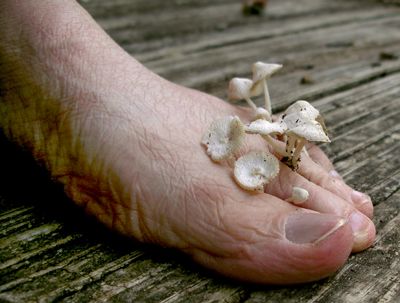by Larry
October, 2013Our Prolifically Fungal FeetOur feet have more fungal growths than any other parts of our bodies. They host up to 100 species of fungi. Surprisingly, many of these actually enhance our health. The fungal landscapes that are our skins are often protected from adverse infections by beneficial or at least benign fungal forms. Thus treatment of unwanted fungus, such as the type which causes Athlete's foot, is best if it eliminates the unwanted species while allowing the continued vitality or rapid restoration of the many that are good for us. The challenge is greater too because fungus is a later evolutionary form and so closer to us than plants. Cures that are effective enough to kill "bad" fungus, such as Tinea pedis, the culprit in most fungal toenail infections and athlete's foot, runs a greater risk than for many herbicidal remedies of killing our own cells and systems too. Though another kingdom than either plants or animals, funguses in a sense are more our kin and like animals than our vegetable cousins. This is one reason it is hard to destroy the fungi involved in toenail infections, Madura foot, and athlete's foot. Once having overcome our bodies' defenses, it is as if they are part of us. Effective management is certainly possible, however, and without destroying the "good" or protective types of fungal growth on our feet. The first steps recommended, though, are preventative. In a locker room, for instance, it is wise to wear flip-flops, to lessen exposure to other people's fungal forests and hence to their foot-loving diseases. Other suggested approaches, if infection has already occurred, include:

If these remedies are insufficient, one probably would be helped by consulting a dermatologist and perhaps getting prescription medications to apply. Funguses that grow on or infect us can be fascinating fields for study. Oddly enough, scientists have not done much research along these lines so far. Just as the world's thick, largely uninvestigated rainforests contain a variety of parasitic species plus many other things that can injure or infect us, yet are also revealing amazing ways plants can make us better, so too funguses, from the once exotic penicillin to common foot fungi, are rich sources of beneficial, health-giving "miracle" remedies awaiting further study and application. Major sources: Some 100 Species of Fungus Live on Our Feet. Christine Dell'Amour in National Geographic; May 22, 2013. Research Reveals Yeasty Beasts Living on Our Skin. Rob Stein in NPR - All Things Considered; May 22, 2013. |